Denny Turner in Thailand
Note from the editor: SDMG instructor Dennny Turner was invited to spend three months in Thailand, where he was accepted to study with the monks at the Wat Sri Suphan in Chiang Mai. Beginning in November, Denny has been an artist-in-residence learning "aluminium embossing" – or what we call chasing and repoussé. He has been teaching this subject in his SDMG classes for a few years, but, in Chiang Mai, according to Denny, he has been learning a great deal from masters of the craft. The Wat has one building called the "Silver Temple", and it is covered in a variety of metals, including silver and aluminum – all of which are worked in embossed style. The temple is still under construction, so the community and the Wat monks have a school where they teach the art, so they can finish the main temple and sell works to the tourists and visitors to benefit the congregation.
Denny's series of reports from Thailand are inaugurated here for his friends and students to enjoy beginning with his New Year's post of 2016. Afterwards, his reports will posted in sequence, from the beginning in November.
New Year's Eve Day, Part 1
January 1, 2016
by Denny Turner
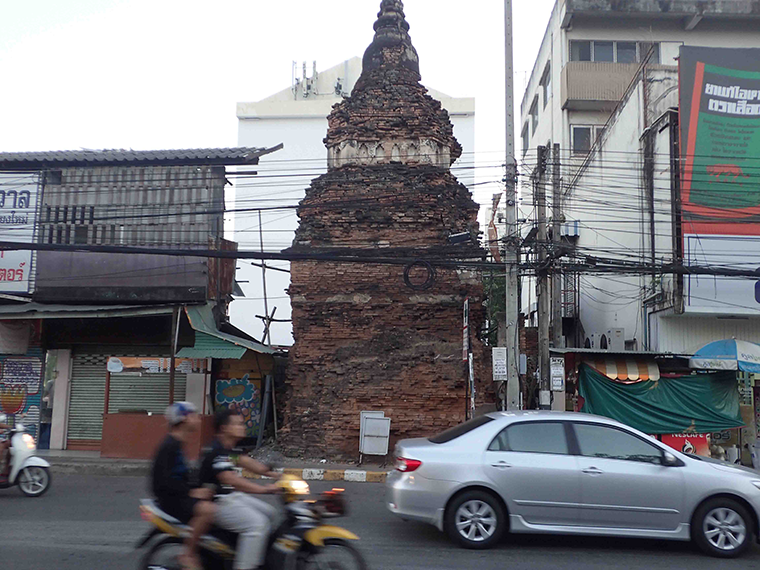
One of many chedi's in various states of disrepair or near-collapse. Note that underground power has not yet come to Chiang Mai.
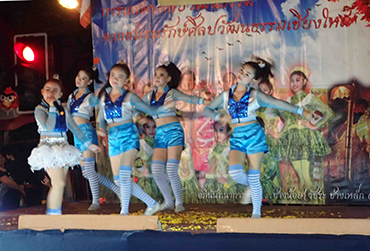
Children perform in Chiang Mai on New Year's eve.
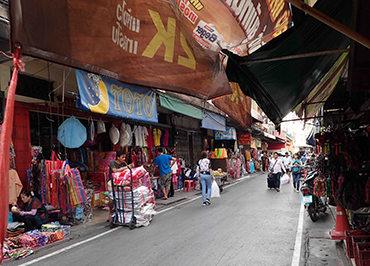
One of the walking streets in the market of Chiang Mai.
HHappiest New Year from Chiang Mai! I want to share a little about the Walking Street street fair scene and some of the things one can see around town. Later I will share Vera's and my New Year's Eve experiences, which were some of the best either of us have ever had.
So, the Old Town of Chiang Mai, where I've spent most of my time has 39 major wats, or temple grounds. But the larger area has a total of 321 temples. It is not much exaggeration to say there is a wat located practically every block, and sometimes there is more than one on each block. Many of these temples are quite old. One person told me that the wats are all owned by the government these days, which protects them from pressures of development. I'm not clear if this is actually true, or if it's some sort of taxation preference, or something short of actual ownership. However, it is true that there are remnant structures nearly everywhere and many of the wats I visit are engaged in new construction.
Most older wats are centered around a chedi or stone tower, with temple buildings and administrative structures, and living domiciles for monks around it. From my balcony window I can see two old chedis with stells (sort of golden pinnacles at the top) completely surrounded by housing. One of the chedis is surrounded by shops on the main street that parallels the canal which defines the square boundary of old Chiang Mai. It sits there, made of crumbling bricks. When one walks by, there are dozens of little 11/2 inch ceramic dishes on which incense or some other little offering has been made and set onto the bricks or at the base. Meanwhile, motorcycles and tu-tuks whizz by just a meter away. Something else to note is the jungle of electrical and cable wiring. it can be seen on every street. Hieronymous Bosch could do a painting of most any street and call it "Electrician's Hell".
In any case, it's common to see chedi's popping up here and there along the streets and in people's back yards. One of the most prominent ones is the main structure of Wat Chedi Luang, one of the largest temples in the city. It's probably almost 100-feet tall and has a base of about the same size. One can see it from any high place in town, including the 8th floor pool of my hotel, even though it's the better part of a mile away. Vera and I spent much of New Year's Eve at Wat Chedi Luang.
At the end of one of the main side streets leading up to the Sunday Walking Street is a stage that is put up and then taken down. It stretches across the entire street. There is a sign that says it is a "cultural exhibit" showing traditional Thai dancing, et cetera. In fact, every week it serves as a glamour contest for little girls (and occasionally boys) to do dance routines and pop songs. Little girls from age 7 or so, up to their late teens, dance and sing in competition. There are 50 or so rows of seats in the street facing the stage, with a judge's platform and an area for girls to primp and get their make-up checked by moms. All the parents and friends (and a fair number of tourists) sit in the seats and watch the shows that go on for several hours. This seems more like a training center for pop culture and not traditional culture. And all this is likely the result of the influence of Western and Japanese music, magazines, and television. We HAVE seen some traditional dance, but in each case it has been at a temple. It's all part of the cross-cultural and changing world of modern Thailand, I suppose.
We visited the Warorot market area. This is the original market for Chiang Mai along the waterfront of the Mei Ping River. Historically, transportation to Chiang Mai was via boat and barge. Elephants were used by the British to help in the harvest of teak and mahogany and large rafts of logs were floated down the river after being dragged to the shores by the elephants. In the 1920s the rail lines was brought up from the south. And eventually the first all-weather roads were put in. But the Warorot market was always the center for commerce on the river. Some of Chiang Mai's oldest remaining buildings are found in this area. It's located to the northeast of the square canal system that otherwise defines old Chiang Mai and is located at the river's edge. The streets in this are very narrow and every crack and crevice of space is used for commerce. And it's where local Thais do a lot of their shopping. Many goldsmiths, fabric shops, hill tribe crafts, household goods, and machine shops are all crammed in side by side. A tourist can get lost without a good map, and it's hard to find a tuk-tuk driver who can find a particular store. Vera met her tailor at one of the silk shops in this area to by silks at a better price than what we'd gotten at the tourist outlet in our previous outing, but only after her tuk-tuk driver was given very explicit directions by our hotel desk lady, Kim. It's a fun place to wander around in and look at all the little shops. And not everyone speaks English here, so a little sign language and patience helps.
* * *
New Year's Eve, Part 2
January 1, 2016
by Denny Turner
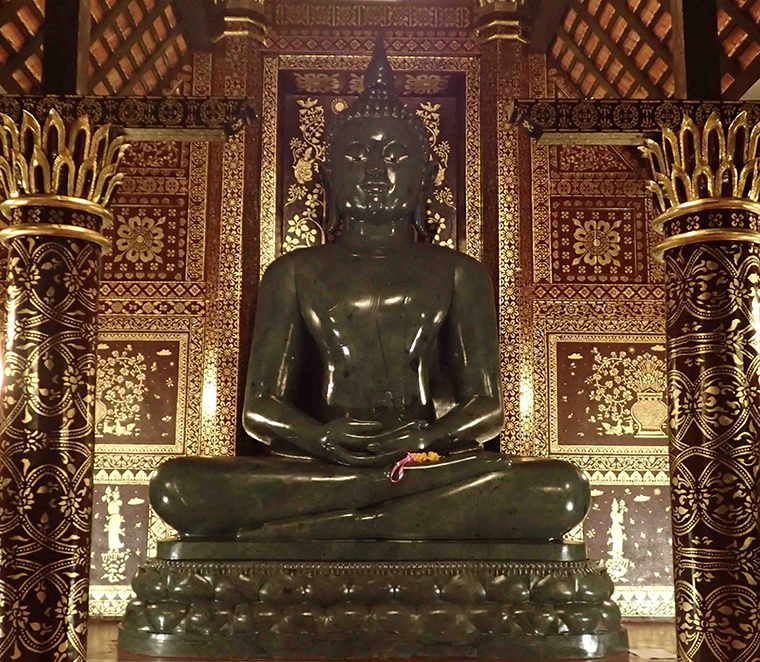
A jade Buddha.
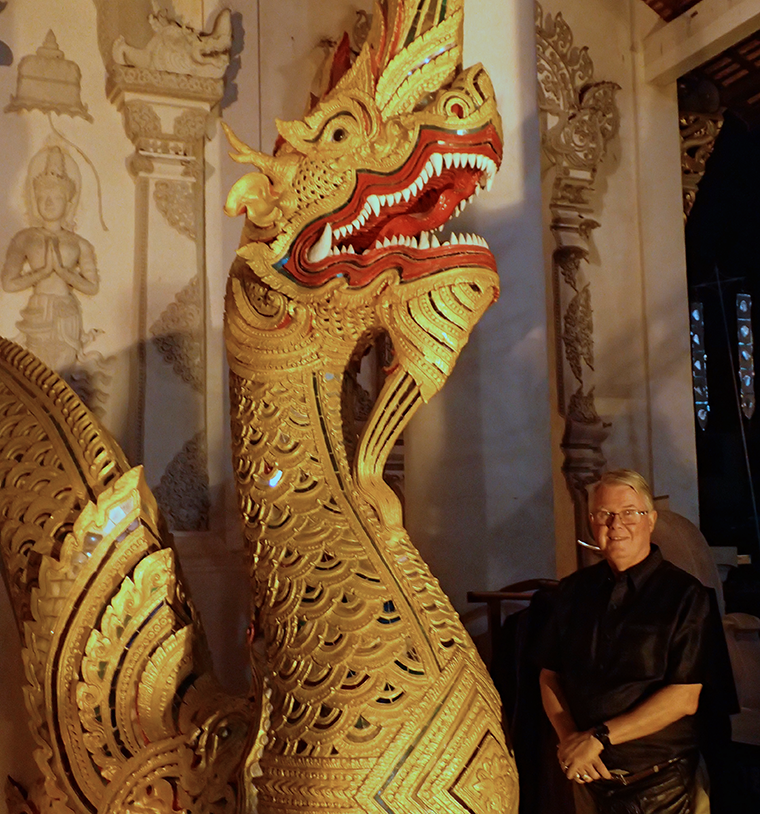
Denny poses next to one of the dragon sculptures of one of the many wats in the Old Town.
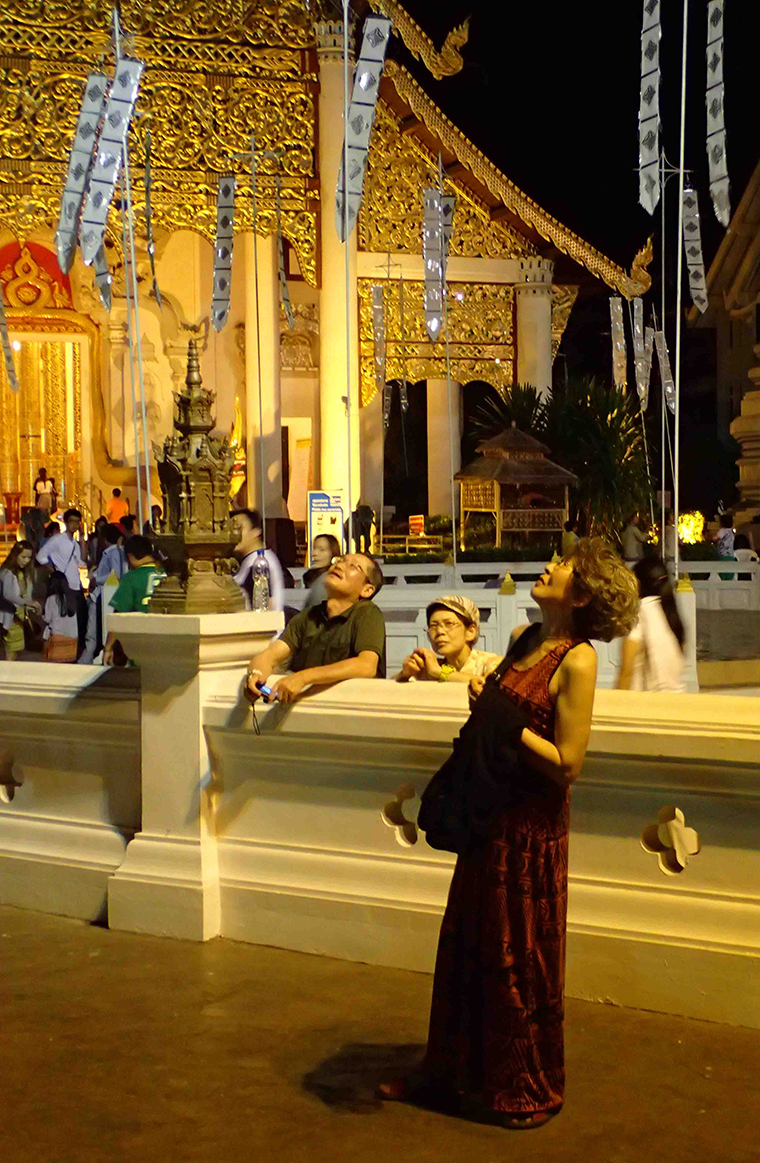
Vera and other New Year's eve celebrants look to the displays illuminating the night sky.
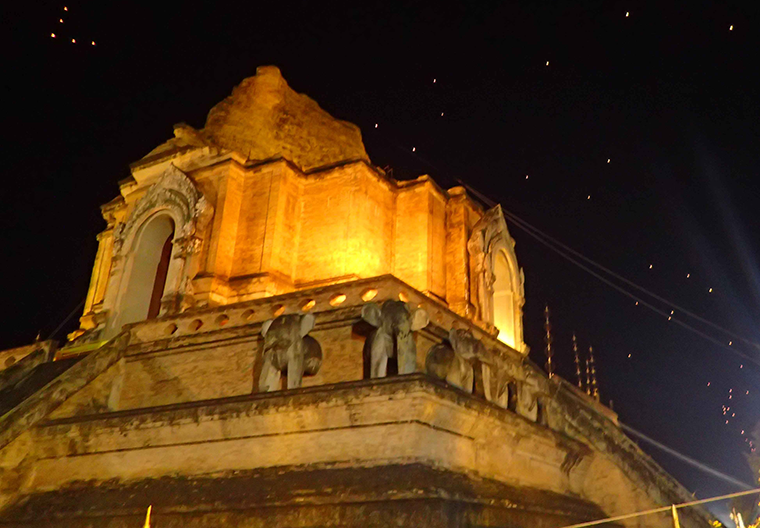
Sculptures of elephants are sentinels of one of the wats of Chiang Mai.
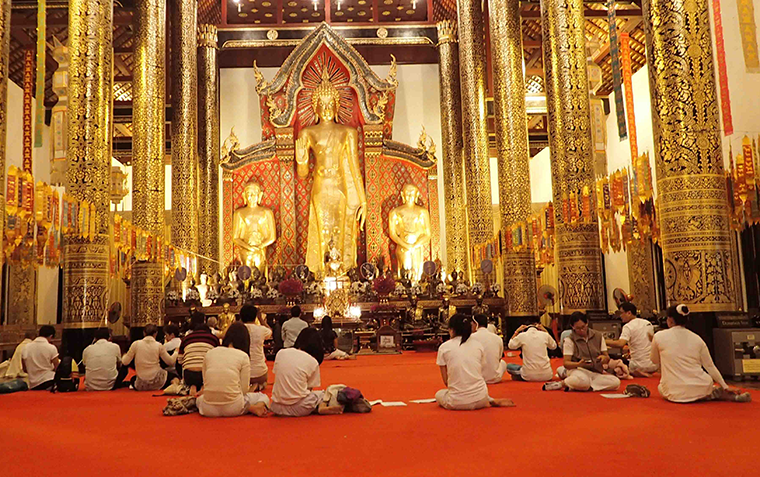
The congregation all dressed in white receives blessings for the New Year before large golden statues of the Buddha.
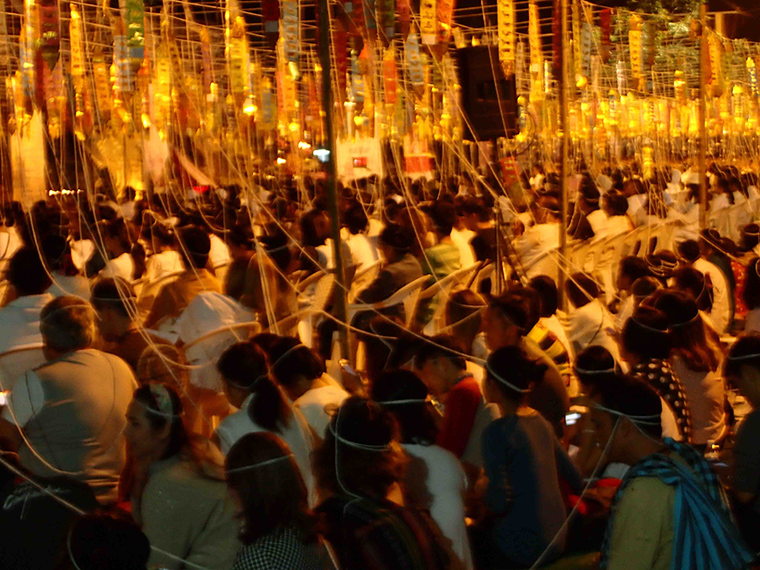
New Year's celebrants at Wat Chedi Luang tie strings to their heads, which are connect to each other and to the Buddha.
Vera and I had a wonderful New Year's Eve. Our hotel, the Smith Residence Hotel, invited everyone for a dinner at 7:00pm. That's the whole hotel of about 70 rooms. "Dr. Smith" is a 60-ish Chinese Thai with a real Thai name that nobody can pronounce, so he goes by Smith. He has done very well for himself. He is an MD in dermatology and is a member of several medical and other boards and commissions in Chiang Mai. He not only owns the Smith Residence Hotel, but also the Smith Suites, a more-upscale hotel nearby, and he owns at least one pharmacy (maybe more), and also a paper company that provides supplies to printers, copy shops, and the like. And maybe more. He is a prominent doctor and businessman in this city. And he is a genuinely very nice guy and generous man.
Dr. Smith comes to the Residence hotel pretty much every day and sits in his office. Not only does he look after his hotel business, but he serves as resident physician to any guest who needs medical care. We've talked to many, many residents who have been treated by Dr. Smith. He treated me when I had an awful case of bronchitis. And he does all his consultation free of charge. He will have very reasonabl -priced, name-brand medications delivered to your room (antibiotics, chest and nasal meds, and insulin for me). He says "hello" with a big smile to everybody. His staff refer to him with the reverence of a near-god. He usually wears a T-shirt and shorts and looks like the guy who might be there to take care of the plumbing. EVERYbody has something nice to say about him. Two days ago, I was in the lobby and he pulled up on a motorcycle with a girl of about 14, who has Down's Syndrome. They were both laughing. He took her into the lobby, then the office for a few minutes. Shortly after they came out, again laughing. She said hello to everybody in the lobby. Then she gave him a big hug and they both hopped back onto the motorcycle and took off again. A relative? A patient? A daughter of a family friend?
Last night, tables were set out with all kinds of foods. There were soups, a potato salad, fried rice with pork, a couple other dishes, and platters and platters of sticky rice and other desserts. Four men were barbequing pork cutlets in the pull-in area in the front veranda (the entire front of the hotel is open to the street). Over 50 people gathered to eat and talk and hang out. Dr. Smith was in the middle of it all, carrying platters, checking on the barbeques, and taking photos. At a certain point we all gathered on the front steps for a group photo, with everybody smiling and laughing. And he does this EVERY year. An amazing man. Life has been good to him and he gives it right back with joy and a smile. He genuinely seems to care about everybody.
Vera had been told by her tailor that on New Year's Eve, her husband would go to their wat at 7:00pm and pray. He would do this until 5:00am the next morning. And we were invited to go visit the wat that same night and participate in the wat's activities.
Not wanting to pray for 9 hours, after dinner Vera and I decided to visit the Wat Chedi Luang, because it is one of the biggest wats, and it is not too far from the hotel. The wat has numerous buildings on the site. There is the main temple for worship with the great Buddha and massive columns. We had been told everybody was welcome and, indeed, we did feel welcome. Because we arrived about 8:00pm and had plenty of time, we sat on the carpet and just looked around and tried to meditate. We stayed there about 1/2 hour, and it was very pleasant. There was a cushioned chair off to one side with a young monk seated. Every so often someone – often a couple – would kneel before him. He would speak to them and tie a colored string around their wrists and then both sides would bow to each other. They would place money in a plate before him. I believe the monk was bestowing blessings for the new year. Occasionally, young children, who were not be able to sit still, ran around a little. No one seemed to mind. There was no one acting as officiant. People just knelt, bowed a little, prayed, and sometimes just chatted quietly amongst themselves. It was very serene and generally quiet. There was a great steel bowl on a table and one could make an offering in an envelope, so we did. All the while we could hear a long monotone prayer or lecture over a P.A. system outside.
We wandered around the main temple building and to the back. Looming over the entire scene is the massive chedi for which the wat is famous. It's a four-sided pyramid with large doors near the top, out of which face four statues of the Buddha. There are very steep steps going up to these doors. And about half way up a ledge large statues of elephants guarding the way up. At the base of the stairs and flanked both sides are two massive stone dragons. All four sides are set up this way.
The wat was set up for New Year's Eve to receive thousands of people, with chairs ranged on three sides of the chedi. When Vera and I arrived at about 8:30pm, there were already several thousand people seated. Almost all were local Thais and almost everyone was dressed in white pants, skirts and tops. For worship services, this seems to be the acceptable dress. But there were many non-worshipers, such as tourists like ourselves, who were dressed in many other styles and colors. Most of us were clicking pictures with our cameras, which nobody seemed to mind. Overhead was a network of wires in a framework. We noted that many people were putting up streamers on these wires, each with a white string. There were thousands of such streamers. I noticed all of them had attached a little form which was filled out on the back with the name and other information about the person who put it out. There were tables all around where one could buy the streamers, scrolls of rolled-up paper, and what looked like more offering envelopes. We did see some small billboards on the sides featuring information about proposed building projects. It took a couple of minutes to figure it out, but all the white strings were attached to other white strings, and they were all connected to the overhead framework. They ran up the steps of the chedi to the statue of the Buddha. As we approached at 11:00pm, we noticed that people were tying the ends of strings around their heads. To me, all of this string business seemed to be saying "We are all connected to the Buddha and we are all connected to each other through the Buddha". And continually the P.A. system broadcast the quiet speaking voice of the head monk.
During the last couple of hours before midnight, we wandered around to the back of great chedi. There we noted that paper lanterns were aloft in the air from all over eastern Chiang Mai. These were the same kinds of lanterns that I had seen during the Lantern Festival before Thanksgiving. For the rest of the evening, hundreds and hundreds of lanterns floated up into the sky, forming a continual backdrop of slowly moving lights.
On the back side of the chedi, we found several buildings with minor "chapels" where there were several huge mahogany trees that were probably 100 years old. Some of the buildings housed some amazing things. One contained a great jade Buddha that was probably 10 feet tall. Another was a reclining Buddha of 20+ feet, with myriad little colored glass tiles all over it, so that it sparkled as you walked past. Another jade Buddha depicted the classical image of Buddha being protected by five massive jade snakes over his head (traditionally, it should be seven). And last was a great sculpture of a big fat man. It's all about vanity and obesity.
We also came upon what I believe is the monks' ordination hall, because it had a sign saying women were not allowed to go inside. This not-so-big building contained amazing paintings on the interior walls, which looked Chinese in style. Also, a wealth of ornamentation surrounding a small golden statue of the Buddha in the center. The opulence here was comparable to some of the settings I've seen in European cathedrals in Italy.
As the evening grew close to midnigh,t we came around the far side of the great chedi to a place where thousands of worshipers were now chanting in unison with the monk's voice on the P.A. system. We spotted a monk on a raised platform who was also chanting. His function was not clear to us. He may have been granting blessings earlier, like the monk in the main temple. A few seconds before midnight, all around the community, firecrackers, bombs and skyrockets started to fill the air. Exactly at midnight, the entire top of the great chedi burst into fireworks. I tried to take a video of all that was going on, but could not decide where in the sky to point the camera. With skyrockets, clouds of floating lanterns, and fireworks right in front of me, I got a little giddy trying to take it all in. And everywhere people were going crazy with their cameras.
After things calmed down, we walked to the front of the wat grounds. There, we found a vendor of the lanterns. We bought a couple and joined others in lighting the wicks and sending ours aloft. Everyone was like little kids with big grins and even some very prayerful expressions.
Still not satisfied, we noted many lanterns were lifting from right next door. The Wat Pan Tao is next to the Chedi Luang, and so we wandered over and entered. There we found all the trees covered in lights, and hundreds of colored electric lanterns strung amongst them. We watched many people launch floating lanterns into the air. Gradually, we worked our way into the deep interior of the wat grounds. We came upon a gorgeous sight. This wat has a great raised platform with a long pond in it with a "beach" behind it. There is a golden Buddha in the middle. And on this night there were a dozen monks in their saffron robes seated around the Buddha facing the congregation. There were hundreds of stationery candles and candles floating in the pond. Lights were everywhere. The head monk was giving a chant and everyone was quiet and attentive. At the conclusion, two monks came forward and used a wisk to spray holy water over the heads of the congregation in blessing. It was a magical event.
Around 1:00am, Vera and I walked home to our hotel, and still there were lanterns in the sky and occasional bangs and pops. We both said it was one of the best New Year's Eve's either of us had experienced. No alcohol, no drunks on the road. No fancy gowns. No midnight kisses (well, almost none, as Vera and I sneaked one during the fireworks). Just glorious lights, amazing sights and a true sense of community among all those with whom we participated. We did spot some night spots outside the wats that were being frequented by young people with loud music, alcohol and motorcycles. So, not all Thais or all tourists got to experience the same New Year's celebration we did.
We hope your own New Year's Eve was fun, memorable, and a great start to the new year.
